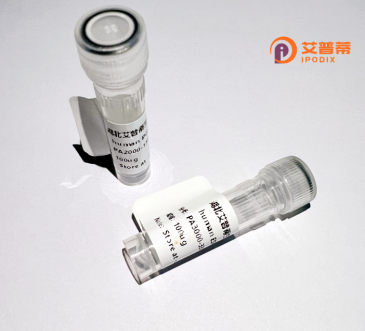
| 纯度 | >90%SDS-PAGE. |
| 种属 | Human |
| 靶点 | BARD1 |
| Uniprot No | Q99728 |
| 内毒素 | < 0.01EU/μg |
| 表达宿主 | E.coli |
| 表达区间 | 1-777aa |
| 氨基酸序列 | MPDNRQPRNRQPRIRSGNEPRSAPAMEPDGRGAWAHSRAALDRLEKLLRCSRCTNILREPVCLGGCEHIFCSNCVSDCIGTGCPVCYTPAWIQDLKINRQLDSMIQLCSKLRNLLHDNELSDLKEDKPRKSLFNDAGNKKNSIKMWFSPRSKKVRYVVSKASVQTQPAIKKDASAQQDSYEFVSPSPPADVSERAKKASARSGKKQKKKTLAEINQKWNLEAEKEDGEFDSKEESKQKLVSFCSQPSVISSPQINGEIDLLASGSLTESECFGSLTEVSLPLAEQIESPDTKSRNEVVTPEKVCKNYLTSKKSLPLENNGKRGHHNRLSSPISKRCRTSILSTSGDFVKQTVPSENIPLPECSSPPSCKRKVGGTSGRKNSNMSDEFISLSPGTPPSTLSSSSYRRVMSSPSAMKLLPNMAVKRNHRGETLLHIASIKGDIPSVEYLLQNGSDPNVKDHAGWTPLHEACNHGHLKVVELLLQHKALVNTTGYQNDSPLHDAAKNGHVDIVKLLLSYGASRNAVNIFGLRPVDYTDDESMKSLLLLPEKNESSSASHCSVMNTGQRRDGPLVLIGSGLSSEQQKMLSELAVILKAKKYTEFDSTVTHVVVPGDAVQSTLKCMLGILNGCWILKFEWVKACLRRKVCEQEEKYEIPEGPRRSRLNREQLLPKLFDGCYFYLWGTFKHHPKDNLIKLVTAGGGQILSRKPKPDSDVTQTINTVAYHARPDSDQRFCTQYIIYEDLCNYHPERVRQGKVWKAPSSWFIDCVMSFELLPLDS |
| 分子量 | 86 kDa |
| 蛋白标签 | His tag N-Terminus |
| 缓冲液 | 冻干粉 |
| 稳定性 & 储存条件 | Lyophilized protein should be stored at ≤ -20°C, stable for one year after receipt. Reconstituted protein solution can be stored at 2-8°C for 2-7 days. Aliquots of reconstituted samples are stable at ≤ -20°C for 3 months. |
| 复溶 | Always centrifuge tubes before opening.Do not mix by vortex or pipetting. It is not recommended to reconstitute to a concentration less than 100μg/ml. Dissolve the lyophilized protein in distilled water. Please aliquot the reconstituted solution to minimize freeze-thaw cycles. |
以下是关于重组人BARD1蛋白的3篇经典参考文献及其摘要概括:
1. **文献名称**:The RING heterodimer BRCA1-BARD1 is a ubiquitin ligase inactivated by a breast cancer-derived mutation
**作者**:Brzović PS, et al.
**期刊/年份**:Mol Cell. 2001
**摘要**:首次解析BRCA1-BARD1复合物的RING结构域相互作用机制,阐明该复合物具有泛素连接酶活性,乳腺癌相关突变会破坏此功能。
2. **文献名称**:BARD1. the BRCA1-interacting protein, is crucial for mammary gland differentiation
**作者**:Irminger-Finger I, et al.
**期刊/年份**:Genes Dev. 2001
**摘要**:发现BARD1缺失会导致乳腺上皮细胞分化异常,证明BARD1-BRCA1复合物在乳腺发育和肿瘤抑制中的双重作用。
3. **文献名称**:Cancer-associated mutations in BARD1 disrupt its DNA repair function through distinct mechanisms
**作者**:Kim H, et al.
**期刊/年份**:Cell Rep. 2020
**摘要**:通过功能基因组学解析不同结构域突变对BARD1的影响,发现N端突变主要破坏染色体定位,C端突变干扰BRCA1结合,导致同源重组修复缺陷。
BARD1 (BRCA1-associated RING domain 1) is a tumor suppressor protein first identified in 1996 through its interaction with BRCA1. a key protein linked to hereditary breast and ovarian cancers. Structurally, BARD1 contains an N-terminal RING domain, three tandem ankyrin repeats, and a C-terminal BRCT domain. The RING domain mediates heterodimerization with BRCA1. forming a complex with E3 ubiquitin ligase activity critical for DNA damage response and genome stability. This complex facilitates ubiquitination of substrates involved in DNA repair, particularly in the homologous recombination (HR) pathway, which repairs double-strand breaks.
BARD1 mutations or dysregulation impair DNA repair mechanisms, leading to chromosomal instability and increased cancer susceptibility. While germline mutations in BARD1 are associated with elevated risks of breast and ovarian cancers (similar to BRCA1), certain variants may also contribute to neuroblastoma and uterine cancer. Beyond its role in DNA repair, BARD1 participates in apoptosis, cell cycle checkpoint control, and replication stress response.
Recombinant human BARD1 is widely used to study its biochemical properties, interaction networks, and the functional impact of cancer-associated mutations. Research on recombinant BARD1 has advanced understanding of its tumor-suppressive mechanisms and potential therapeutic targets, particularly in cancers with defective HR pathways. Its clinical relevance extends to biomarker development and PARP inhibitor-based therapies for BARD1/BRCA1-deficient tumors.
×